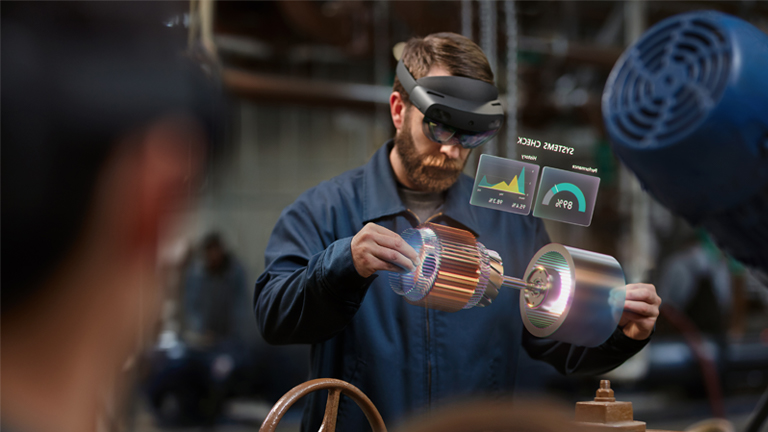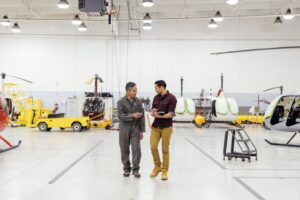
State-of-the-art manufacturing: new skills, new roles, new possibilities

In previous posts in this series, we’ve discussed how IoT is changing the manufacturing industry, ways to use IoT data more effectively, and how to think beyond the factory floor when rolling out IoT technology. Now we come to perhaps the most important topic of all: the impact of IoT on the people who make manufacturing happen.
Whether they’re plant designers, operations managers, or firstline workers, they’re at the intersection of machine efficiency and human creativity. As data, automation, and AI enable new levels of efficiency, the old adage remains true: Your people are your greatest asset. Making the most of their creativity and skill in the IoT era is a strategic advantage. Here are some of the shifts in human capital underway in manufacturing, from upskilling firstline workers to virtual design.
Freeing factory designers to innovate
Data-driven transformation starts before a plant is even built, changing how designers and process engineers are doing their jobs. In the past, design was driven by industry knowledge and practical experience, whether it was laying out piping or figuring out the square footage of drying ovens. People designed a plant on paper or using CAD software that produced static plans. Performance depended on how well the designers could piece together physics and materials science, leavened by their professional experience.
IoT data changes that. Today, the most sophisticated plants start life as 3D digital simulations. Designers create a digital twin that accounts for physics, processes, and optimal equipment effectiveness. Designers experiment and evaluate new approaches at low cost and risk—which requires a new mindset and new skills. Knowing how to depict something on a drawing has become less important than understanding how to model the real world effectively and optimizing the simulation. Designers spend more time on innovation and less on rote imitation.
Arming shop-floor workers with data
From steam-powered looms to assembly robots, the history of manufacturing is filled with examples of technology changing how people work. Increased efficiency boosts profits and drives down prices for consumers—and it also changes how people work. For example, IDC predicts that by 2021, 60 percent of manufacturers will have empowered shop-floor workers with augmented reality (AR), intelligent apps, and co-bots. The report anticipates that workers will achieve productivity gains of up to 7 percent and enjoy more attractive work environments. Industry 4.0 is about arming every employee with deep, holistic knowledge about the business. It’s an opportunity for everyone to look beyond their niche roles to find ways to help the overall business, and its customers, thrive.
In the traditional process or discrete manufacturing plant, firstline workers staff the facility in teams 24 hours a day. Manual intervention and troubleshooting of machines are the norm, requiring people to specialize in certain types of equipment and rely on knowledge passed down from worker to worker.
Compare this with the state of the art: Most plant functions are operated remotely from a centralized location. A team of two manage a mega-plant behind a single pane of glass. Their skills are less in knowing which button to push or which valve to open and more in understanding the holistic operation of the plant through data and visualizations. In addition to greatly increased efficiency, the ability to perform tasks remotely can greatly improve safety, especially in potentially hazardous environments such as mines and chemical plants.
Upskilling firstline workers
The best candidates for these new jobs are often the very firstline workers who staffed the traditional factory. Upskilling the most competent and creative individuals enables you to combine practical experience with IoT-driven efficiency. Those who transition successfully to this new environment may experience higher job satisfaction as they are responsible for a higher level of operational quality and have a greater impact on the business as a whole.
They’re also better prepared than ever before. With IoT-connected AR devices such as Microsoft HoloLens, workers are being trained using a digital twin before going to work in the real world. Learning in a realistic 3D environment is more effective than studying books or watching videos. Inside the plant, AR can be used to guide people through repairs or plant operations, helping them be more productive in less time—and further improving the safety and quality of their work.
Throughout the workday, digital communication channels and even AI-driven conversation bots help workers make the most of their skills and knowledge. Whether it’s sharing data with a customer during a repair or having a bot guide a process step by step, firstline workers are leveraging connectivity to do their jobs better.
Equipping every employee with business insights
Prior to Industry 4.0, field service and plant workers had their attention divided between reams of documentation and their actual jobs. In modern manufacturing, work orders, quality processes, and checklists are digitized so they can be completed with a tap. In some cases, a sensor can automatically confirm that a step has been performed. Employees can work faster and focus on the task at hand, while the business has greater assurance that quality processes have been followed.
Piramal Glass, which produces 1,375 tons of glass units per day across 60 production lines, was able to eliminate paper logbooks and achieve real-time data collection and analysis using an IoT platform. Plant personnel have easy access to production and defect metrics, quality control workflows, and role-specific KPIs. Actionable alerts are sent through SMS, email, and push notifications whenever there is an anomaly detected or a drop in production efficiency.
Exciting possibilities for operations managers
This level of real-time visibility and control also has a positive impact on customers. Food equipment manufacturer Bühler has created an end-to-end, track-and-trace solution for grain. In the past, there were limited opportunities to gather data during the food processing lifecycle, and accuracy depended on people filling out paper forms all along the supply chain.
Now, with a combination of IoT and blockchain technology, every step is digitized, and everything from grain-sorting machinery to the temperature of shipping containers can be tracked and monitored automatically. Employees can focus on their areas of expertise, and the quality of the end product can be demonstrated with better certainty than ever before.
The people involved in these projects are excited about their increased impact. “We’re not only going to get economic results, but hopefully we can transform and save lives at the same time,” says Ben Deefholts, senior research engineer at Bühler. “It’s the most exciting and valuable project I’ve worked on in my 40 years with the company. It’s a really big thing.”
Empowering field service to fix things before they break
When it comes to maintenance and repairs, IoT data and digital twins will enable workers to perform prescriptive maintenance and identify root causes. The traditional approach to plant maintenance is to maintain equipment on a one-size-fits-all schedule, based on average lifespans of parts and machines—or after something breaks.
With the right data, field service workers can identify when maintenance is indicated based on the actual performance of a machine and long before problems occur. What’s more, they can understand what’s really going on—for example, whether a clog has been caused by corrosion or a biofilm buildup—and take targeted steps to address it. This is another example of where human knowledge and machine learning combine for a better outcome.
Digital services job creation
In addition to efficiency and productivity gains, manufacturers are pursuing Industry 4.0 because it enables new business models—and new jobs along with them. The chief digital officer was not a common role in manufacturing a few years ago, but now entire teams of people are focused on digital opportunity. At Bühler, dozens of people are doing this type of work. They are focused on creating the next-generation services that may ultimately become more valuable to the business than the machines the company produces.
Manufacturing has always focused on using technology to maximize the value of human ingenuity. In the Industry 4.0 era, IoT is a multiplier for the creativity and expertise of individuals and teams. Yes, new skills and mindsets are becoming standard requirements for manufacturing jobs. But the rewards in job satisfaction and impact on the overall business are proving to be more than worth the challenges.
Learn more about how Microsoft is helping manufacture a better future.




